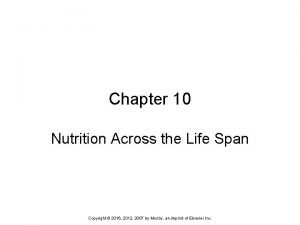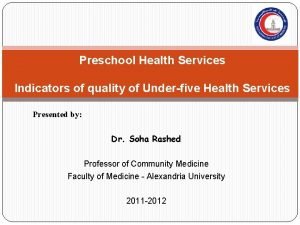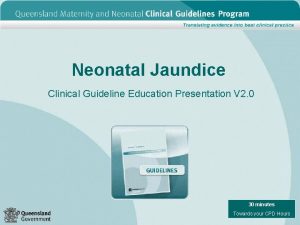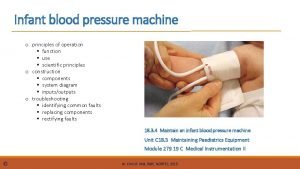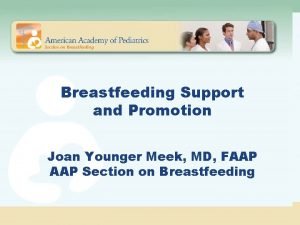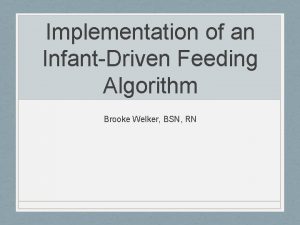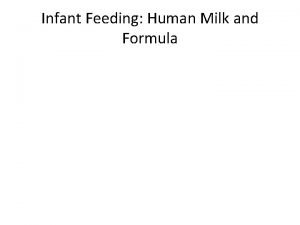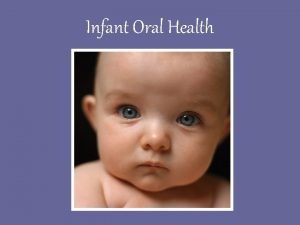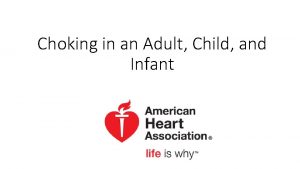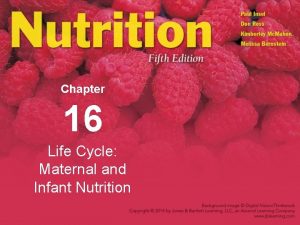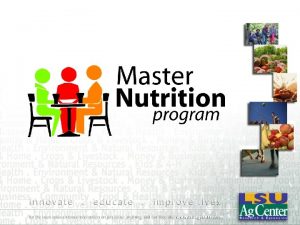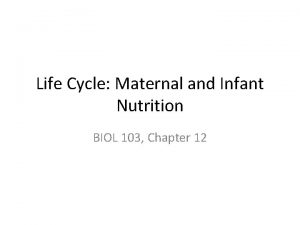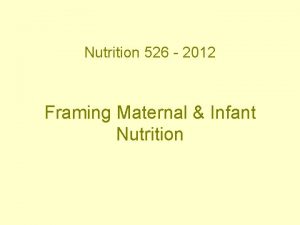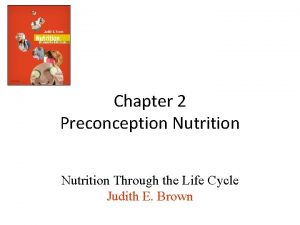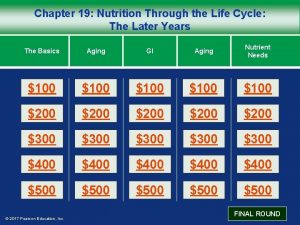Chapter 8 Infant Nutrition Through the Life Cycle

































































- Slides: 65

Chapter 8 Infant Nutrition Through the Life Cycle Judith E. Brown

Assessing Newborn Health • Birthweight as an Outcome – Full-term infant (37 to 42 wks) • Typical weight 2500 -3800 g (5. 5 to 8. 5 lbs) • Typical length 47 -54 cm (18. 5 to 21. 5 in) • 88% of U. S. infants are born full-term

Infant Mortality • Infant mortality defined as death that occurs within the first year • Major cause is low birthweight (< 2500 g) • Other leading causes inlcude: – 1) congenital malformations, – 2) preterm births, and – 3) SIDS

Combating Infant Mortality • Factors associated with mortality: • • • Social and economic status Access to health care Medical interventions Teenage pregnancy Availability of abortion services Failure to prevent preterm & LBW births

Resources to Combat Infant Mortality – Resources and prevention programs to combat infant mortality • Medicaid • Child Health Initiatives Program (CHP) • Early Periodic Screening, Detection, and Treatment Program (EPSDT) • WIC and CDC (Nutrition Surveillance Program) • Bright Futures

Assessing Newborn Health • Standard Newborn Growth Assessment – “Appropriate for gestational age” (AGA) – “Small for gestational age” (SGA) and “intrauterine growth retardation” (IUGR) mean newborn was <10 th % wt/age – “Large for gestational age” (LGA) means newborn was >90 th % wt/age

Infant Development • Newborns: – Hear and move in response to familiar voice – CNS is immature resulting in inconsistent cues for hunger and satiety – Strong reflexes, especially suckle and root (reflexes are protective for newborns)

Infant Development • Terms Related to Development: – Reflex—automatic response triggered by specific stimulus – Rooting reflex—infant turns head toward the cheek that is touched – Suckle—reflex causing tongue to move forward and backward – http: //www. youtube. com/watch? v=ULno 8 FAm t 0 c

Major Reflexes Found in Newborns

Motor development • Motor development: ability to control voluntary muscles • Motor development is top down— controls head first and lower legs last • Muscle development from central to peripheral • Influences ability to feed self & the amount of energy expended

Gross Motor Skills

Critical Periods of Infant Development • A fixed period of time in which certain behaviors or developments emerge • Necessary for sequential behaviors or developments • If the critical period is missed, there may be difficulty later on

Cognitive Development of Infants • Factors that impact cognition – Sensorimotor development – Adequate nutrient intake – Positive social and emotional interactions – Genetics

Sensorimotor Stage of Development

Digestive System Development of Infants • Fetus swallows amniotic fluid which stimulates intestinal maturation and growth • At birth the healthy newborn can digest fats, protein and simple sugars. • Common problems include gastroesophageal reflux (GER), diarrhea, and constipation

Digestive System Development of Infants • Factors that impact rate of food passage in GI – Osmolarity of foods or liquids – Colon bacterial flora – Water and fluid balance in the body

Parenting • New parents must learn: – Infant’s cues of hunger and satiety – Temperament of infant – How to respond to infant cues

Energy and Nutrient Needs • The recommendations for infants are from the Dietary Reference Intakes (DRI), National Academy of Medicine, AAP and the ADA – Caloric needs – Protein needs – Fats – Metabolic rate, calories, fats and protein—how do they all tie together?

Energy Needs • Energy (Calories): – 108 kcal/kg/day from birth to 6 months (range from 80 to 120) – 98 kcal/kg/day from 6 to 12 months • Factors that influence calorie needs – Weight and growth rate – Sleep/wake cycle – Temperature and climate – Physical activity – Metabolic response to food – Health status

Protein Needs • Protein Needs – 2. 2 g/kg/day from birth to 6 months – 1. 6 g/kg/day from 6 to 12 months • How much is that? – Newborn weighing 4 kg (8. 8 lbs) needs 2. 2 X 4 = 8. 8 g protein – 6 -month-old weighing 8 kg (17. 6 lbs) needs 1. 6 X 8 = 12. 8 g protein • Protein needs are similar to that of energy but are also influenced by body composition

Fat Needs • Breastmilk contains about 55% calories from fat • Infants need cholesterol for gonad and brain development • Breast milk contains short-chain and mediumchain fatty acids (in addition to the long-chain) – Easier to digest and utilize than long-chain fatty acids

Metabolic Rate, Calories, Fats and Protein • Metabolic rate of infants is highest of any time after birth – The higher rate is related to rapid growth and high proportion of muscle – Low carbohydrate and/or energy intake results in protein catabolism impacting growth

Other Nutrients and Nonnutrients – Fluoride— 0. 1 - 0. 5 mg/d depending on age (too much may cause tooth discoloration) – Vitamin D— 400 IU/day – Sodium— 120 mg/day – Fiber—no recommendations – Lead—None—may be toxic

Physical Growth Assessment • Newborns double birthweight by 4 -6 mos and triple it by 1 yr • Growth reflects: – Nutritional adequacy – Health status – Economic & environmental adequacy • There is a wide range of growth =normal • Calibrated scales & recumbent length measurement board required for accurate measures

Typical Gains in Wt and Ht for Age in Infancy • Calibrated scales & recumbent length measurement board required for accurate measures

Physical Growth Assessment

Measuring Growth in Infants

Interpretation of Growth Data • Measures over time identify change in growth rate and need for intervention • Warning signs: – Lack of Wt or Lt gain – Plateau in Wt, Lt or HC for > 1 month – Drop in Wt without regain in a few weeks

Feeding in Early Infancy Breast Milk and Formula • AAP & ADA recommend exclusive breast feeding for 1 st 6 months & continuation to 1 yr • Initiate breast feeding right after birth • Growth rate and health status indicate adequacy of milk volume • Standard infant formula provides 20 cal/oz • Preterm formula provides 22 -24 cal/oz

Typical Daily Volumes for Young Infants Not Being Breastfed

How Infant Formulas Are Modified Compared to Breast Milk Cow’s Milk-Based Formula • 7% of calories from Protein • 38% calories from carbs • 55% calories from fat • 9 -12% calories from Protein • 41 -43% calories from carbs • 48 -50% calories from fat Table 8. 6 gives an overview of the compostion of commercially available infant formulas compared to breast milk. Table 8. 7 compares various formulas to one another.

Cow’s Milk during Infancy • Whole, reduced-fat or skim cow’s milk should not be used in infancy • Iron-deficiency anemia linked to early introduction of cow’s milk • Anemia linked to: – GI blood loss – Calcium & phosphorus – Displacement of iron-rich foods

Soy Protein-Based Forumla during Infancy • Soy protein in place of milk protein should be limited in its use • There is little scientific evidence for benefit of increase soy over milk-based • The use of soy formula is not recommended – For managing infantile colic – Or as an advantage of cow’s milk formula for preventing allergy in healthy at-risk infants

Development of Infant Feeding Skills • Infants born with reflexes & food intake regulatory mechanism • Inherent preference for sweet taste • At 4 -6 wks, reflexes fade; infant begins to purposely signal wants & needs • Table 8. 8 shows infant developmental milestones and readiness for feeding skills

Development of Infant Feeding Skills • Cues infants may give for feeding readiness include: – Watching the food being opened in anticipation of eating – Tight fists or reaching for spoon – Irritation if feeding too slow or stops temp. – Playing with food or spoon – Slowing intake or turning away when full – Stop eating or spit out food when full

Introduction of Solid Foods • Food offered from spoon stimulates muscle development • At 4 -6 months, offer small portions of semisoft food on a spoon once or twice each day

Recommendations for Introduction of Solid Foods • • Infant should not be overly tired or hungry Use small spoon with shallow bowl Allow infant to open mouth & extend tongue Place spoon on front of tongue with gentle pressure Avoid scraping spoon on infant’s gums Pace feeding to allow infant to swallow First meals may be 5 -6 spoons over 10 minutes

The Importance of Infant Feeding Position • Improper positioning may cause choking, discomfort, and ear infections • Position young bottle-fed infants in a semiupright • Spoon-feeding should be with infant seated with back and feet supported • Adults feeding infants should be directly in front of infant making eye contact

Preparing for Drinking from a Cup • • Offer water or juice from cup after 6 months Wean to a cup at 12 to 24 months First portion from cup is 1 -2 oz Early weaning may result in plateau in weight (due to reduced calories) and/or constipation (from low fluid intake)

Preparing for Drinking from a Cup • Changing from a bottle to a covered “sippy” cup with a small spout is not the same developmental step as weaning to an open cup • Open cup drinking skills also encourage speech development

Food Texture and Development “They say fingers were made before forks and hands before knives. ” − Jonathan Swift

Food Texture and Development • Can swallow pureed foods at 4 -6 months • Early introduction of lumpy foods may cause choking • Can swallow very soft, lumpy foods at 6 -8 months • By 8 -10 months, can eat soft mashed foods


First Foods • 6 months—iron-fortified baby cereal – Rice cereal is hypoallergenic • 6 months—fruits and vegetables • Only one new food over 2 -3 days • Commercial baby foods are not necessary but do provide sanitary and convenient choices • 9 -12 months soft table foods

Inappropriate and Unsafe Food Choices • Foods that choke infants – – – Popcorn Peanuts Raisins, whole grapes Stringy meats Gum & gummy-textured candy, hard candy or jelly beans – Hot dogs – Hard fruits or vegetables

Water • Breast milk or formula provide adquate water for healthy infants up to 6 months. • All forms of fluids contribute to water intake • Additional plain water needed in hot, humid climates • Dehydration is common in infants

Water • Pedialyte or sports drinks provide electrolytes but lower in calories than formula or breast milk • Limit juice – AAP recommends juice is not needed to meet the fluid needs before the age of 6 months • Avoid colas and tea

How Much Food is Enough for Infants? • Infants vary in temperament • Crying or fussiness may be interpreted as hunger resulting in overfeeding • First foods may appear to be rejected due to immature tongue movement

How Infants Learn Food Preferences • Infants learn food preferences • Flavor of breast milk influenced by mother’s diet • Genetic predisposition to sweet taste • Food preference from infancy sets stage for lifelong food habits

Nutrition Guidance • Guidance materials are available – WIC program – Bright Future in Practice • Infant feeding recommendations from nutrition education materials are sampled in Table 8. 9

Nutrition Guidance • Infants and exercise – Adult exercise and fitness do not apply to infants • Stimulating environment is recommended to allow infants to explore and move as a part of their developmental milestones

Nutrition Guidance • Supplements for infants – Fluoride—for breastfed infants or if in any area with no fluoridated water – Iron—if mother was anemic – Vitamin B 12—for vegans – Vitamin D—needed if low sun exposure or exclusively breastfed

Common Nutritional Problems and Concerns • • • Failure to thrive (FTT) Colic Iron-deficiency anemia Constipation Dental caries Food allergies

Common Nutritional Problems and Concerns • Failure to thrive (FTT) – Inadequate wt or lt gain – Organic—diagnosed medical illness – Nonorganic—not based on medical diagnosis • Intervention for FTT – May be complex and involve a team approach including the registered dietitian

Common Nutritional Problems and Concerns

Colic • The sudden onset of irritability, fussiness or crying • Episodes may appear at the same time each day • Disappear at 3 rd or 4 th • Cause unknown but associated with GI upset, infant feeding practices

Iron-deficiency Anemia • Less common in infants than in toddlers • Irons stores in the infant reflect the iron stores of the mother • More common in low-income families • Breastfed infants may be given iron supplements and iron-fortified cereals at 4 -6 months • Iron-fortified versus “Low-iron” formula

Diarrhea and Constipation • Infants typically have 2 -6 stools per day • Causes of diarrhea & constipation: – Viral and bacterial infections – Food intolerance – Changes in fluid intake

Diarrhea and Constipation • To avoid constipation assure adequate fluids • Diarrhea may be a serious problem-continue to feed the usual diet during diarrhea

Prevention of Baby Bottle Caries and Ear Infections • Caries and ear infections linked to feeding practices • Feeding techniques to reduce caries and ear infections – Limit use of bedtime bottle – Offer juice in cup – Only give water bottles at bedtime – Examine and clean emerging teeth

Food Allergies and Intolerances • About 6 -8% of children < 4 yrs have allergies • Absorption of intact proteins causes allergic reactions • Common symptoms are wheezing or skin rashes • Treatment may consist of formula with hydrolyzed proteins

Lactose Intolerance • Inability to digest the disaccharide lactose • Characterized by cramps, nausea and pain and alternating diarrhea and constipation • Lactose intolerance in uncommon and tends to be overestimated • Many infants “outgrow” lactose intolerance

Cross-Cultural Considerations • Baby foods do not reflect ethnic diversity • Some cultural practices are harmful; others are harmless or helpful • Cultural considerations may impact willingness to participate in assistance programs

Vegetarian Diets • Infants receiving well-planned vegetarian diets grow normally • Breastfed vegan infants need supplements – Vitamin D – Vitamin B 12 – Possibly iron and zinc

Nutrition Intervention for Risk Reduction • Early Head Start Program – Works with families at risk such as drug abuse, infants with disabilities, or teenage mothers • Model program: newborn screening – Phenylketonuria, galactosemia, hypothyroidism, or sickle-cell anemia
 Nutrition through life cycle
Nutrition through life cycle Chapter 7 nutrition for life
Chapter 7 nutrition for life Infants, children and adolescents 8th edition
Infants, children and adolescents 8th edition The embryo gets nutrition from mother through
The embryo gets nutrition from mother through Chapter 5 two-cycle and four-cycle engines answers
Chapter 5 two-cycle and four-cycle engines answers Grade 11 animal nutrition
Grade 11 animal nutrition Nutrition across the lifespan
Nutrition across the lifespan Through one man
Through one man Furcation dental definition
Furcation dental definition Conversion of timber advantages and disadvantages
Conversion of timber advantages and disadvantages Night of the scorpion is written by
Night of the scorpion is written by Chapter 17 lesson 2 heredity and genetics
Chapter 17 lesson 2 heredity and genetics Chapter 19 section 2 the life cycle of stars answer key
Chapter 19 section 2 the life cycle of stars answer key Hart plain infant school
Hart plain infant school Drdp modified essential view
Drdp modified essential view The infant industry argument
The infant industry argument Intraosseous meaning
Intraosseous meaning Keeping an infant safe and well section 7-3
Keeping an infant safe and well section 7-3 Imr equation
Imr equation Pediatric bls algorithm
Pediatric bls algorithm Vastus lateralis injection site
Vastus lateralis injection site Description of pain
Description of pain Direct coombs test pregnancy
Direct coombs test pregnancy Mortality rate formula
Mortality rate formula Kenmore park infant and nursery school
Kenmore park infant and nursery school Primitive reflexes chart
Primitive reflexes chart What is habituation
What is habituation Juan soriano la niña muerta; the dead girl; dead infant
Juan soriano la niña muerta; the dead girl; dead infant Infant reflexes chart
Infant reflexes chart Infant blood pressure
Infant blood pressure Infant incubator working principle
Infant incubator working principle Botulism symptoms
Botulism symptoms Llf meaning cpr
Llf meaning cpr Convent of the holy infant jesus school
Convent of the holy infant jesus school Promoting infant health section 7-2
Promoting infant health section 7-2 Personality development in infants
Personality development in infants Weight gain in infant
Weight gain in infant Compression to ventilation ratio adults
Compression to ventilation ratio adults Saguaro infant care and preschool
Saguaro infant care and preschool Sparhawk nursery
Sparhawk nursery An infant's growth refers to changes in
An infant's growth refers to changes in Pregnancy and infant cohort monitoring and evaluation
Pregnancy and infant cohort monitoring and evaluation Objective of cpr
Objective of cpr Infant driven feeding readiness scale
Infant driven feeding readiness scale Femoral pulse in child
Femoral pulse in child Dormers wells infant school
Dormers wells infant school Woodfield infant school
Woodfield infant school Papoose infant spinal immobilizer
Papoose infant spinal immobilizer Isomil df
Isomil df Infant/toddler sensory profile score sheet
Infant/toddler sensory profile score sheet Embrace infant warmer
Embrace infant warmer Social impulses foster infant language
Social impulses foster infant language Social impulses foster infant language
Social impulses foster infant language Brigance scoring chart 3 year-old
Brigance scoring chart 3 year-old Phoenix infant academy
Phoenix infant academy Walter infant school
Walter infant school Wood street infant school
Wood street infant school Infant mortality rate formula
Infant mortality rate formula Infant industry
Infant industry Infant
Infant Downs view infant school
Downs view infant school Ernest hemingway for sale
Ernest hemingway for sale Infant
Infant Infant age
Infant age Decardron
Decardron Infant mortality rate formula
Infant mortality rate formula






